General Prologue



The General Prologue is the first part of The Canterbury Tales by Geoffrey Chaucer.
Synopsis[]
The frame story of the poem, as set out in the 858 lines of Middle English which make up the General Prologue, is of a religious pilgrimage. The narrator, Geoffrey Chaucer, is in The Tabard Inn in Southwark, where he meets a group of "sundry folk" who are all on the way to Canterbury, the site of the shrine of Saint Thomas Becket, a martyr reputed to have the power of healing the sinful.
The setting is April, and the prologue starts by singing the praises of that month whose rains and warm western wind restore life and fertility to the earth and its inhabitants. The setting arguably takes place in April being that travel conditions are not up for travel in real life during this time.[1] This abundance of life, the narrator says, prompts people to go on pilgrimages; in England, the goal of such pilgrimages is the shrine of Thomas Becket. The narrator falls in with a group of pilgrims, and the largest part of the prologue is taken up by a description of them; Chaucer seeks to describe their 'condition', their 'array', and their social 'degree.' According to The Norton Anthology of English Literature: Volume 1, "The narrator, in fact, seems to be expressing chiefly admiration and praise at the superlative skills and accomplishments of this particular group, even such dubious ones as the Friar's begging techniques or the Manciple's success in cheating the learned lawyers who employ him".[2] Chaucer arguably points out the virtues and vices of each of the pilgrims as described within the work. It is up to the reader to determine the gravity and underlying meaning of Chaucer's methods in doing so
- To telle yow al the condicioun,
- Of ech of hem, so as it semed me,
- And whiche they weren, and of what degree,
- And eek in what array that they were inne,
- And at a knyght than wol I first bigynne.
The pilgrims include a knight, his son a squire, the knight's yeoman, a prioress accompanied by a second nun and the nun's priest, a monk, a friar, a merchant, a clerk, a sergeant of law, a franklin, a haberdasher, a carpenter, a weaver, a dyer, a tapestry weaver, a cook, a shipman, a doctor of physic, a wife of Bath, a parson, his brother a plowman, a miller, a manciple, a reeve, a summoner, a pardoner, the Host (a man called Harry Bailey), and a portrait of Chaucer himself. At the end of the section, the Host proposes that the group ride together and entertain one another with stories. He lays out his plan: each pilgrim will tell two stories on the way to Canterbury and two on the way back. Whoever has told the most meaningful and comforting stories, with "the best sentence and moost solaas" (line 798) will receive a free meal paid for by the rest of the pilgrims upon their return. The company agrees and makes the Host its governor, judge, and record keeper. They set off the next morning and draw lots to determine who will tell the first tale. The Knight wins and prepares to tell his tale.[3]
The Tales[]
- General Prologue
- The Knight's Tale
- The Miller's Tale
- The Reeve's Tale
- The Cook's Tale {Unfinished}
- The Man of Law's Tale
- The Tale of Gamelyn intended by Chaucer for a tale by "The Squire"?
- The Wife of Bath's Tale
- The Friar's Tale
- The Summoner's Tale
- The Clerk's Tale
- The Merchant's Tale
- The Squire's Tale
- The Franklin's Tale
- The Physician's Tale
- The Pardoner's Tale
- The Shipman's Tale
- The Prioress's Tale
- Sir Thopas Tale told by Chaucer {Unfinished}
- The Tale of Melibee told by Chaucer
- The Monk's Tale
- The Nun's Priest's Tale
- The Second Nun's Tale
- The Canon's Yeoman's Tale
- The Manciple's Tale
- The Parson's Tale
- Chaucer's Retraction
- The Plowman's Tale, a 15th-century addition to the Canterbury Tales
- Siege of Thebes (poem), a 15th-century addition to the Canterbury Tales
- Prologue and Tale of Beryn, a 15th-century addition to the Canterbury Tales which tells of the epilogue after the Pilgrims arrive in Canterbury
Gallery of the Pilgrims[]

The Knight

The Squire

The Prioress
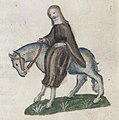
The Second Nun
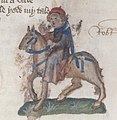
The Nun's Priest

The Monk

Herbert The Friar
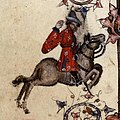
The Merchant
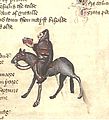
The Clerk of Oxford

The Sergeant of Law
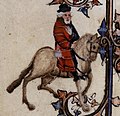
The Franklin

Roger The Cook

The Shipman
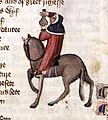
The Physician

The Wife of Bath

The Parson

Robin The Miller

The Manciple

Oswald The Reeve

The Summoner
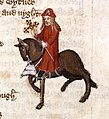
The Pardoner

Geoffrey Chaucer from the Ellsmere manuscript of the Canterbury Tales

The Canon Yeoman {not part of the original prologue but added at the end of the Tales}
Structure[]
The General Prologue establishes the frame for the Tales as a whole (or of the intended whole) and introduces the characters/story tellers. These are introduced in the order of their rank in accordance with the three medieval social estates (clergy, nobility, and commoners and peasantry). These characters are also representative of their estates and models with which the others in the same estate can be compared and contrasted.
The structure of the General Prologue is also intimately linked with the narrative style of the tales. As the narrative voice has been under critical scrutiny for some time, so too has the identity of the narrator himself. Though fierce debate has taken place on both sides, (mostly contesting that the narrator either is, or is not, Geoffrey Chaucer), most contemporary scholars believe that the narrator is meant to be some degree of Chaucer himself. Some scholars, like William W. Lawrence, claim that the narrator is Geoffrey Chaucer in person. While others, like Marchette Chute for instance, contest that the narrator is instead a literary creation like the other pilgrims in the tales.[4]
Manly attempted to identify pilgrims with real 14th century people. In some instances such as Summoner and Friar, he attempts localization to a small geographic area. The Man of Law is identified as Thomas Pynchbek (also Pynchbeck) who was chief baron of the exchequer. Sir John Bussy was an associate of Pynchbek. He is identified as the Franklin. The Pembroke estates near Baldeswelle supplied the portrait for the unnamed Reeve.[5]
Sebastian Sobecki argues that the General Prologue, in which the innkeeper and host Harry Bailey introduces each pilgrim, is a pastiche of the historical Harry Bailey's surviving 1381 poll-tax account of Southwark's inhabitants.[6]
Translation[]
First 18 lines[]
The following are the first 18 lines of the General Prologue. The text was written in a dialect associated with London and spellings associated with the then-emergent Chancery Standard.
| First 18 lines of the General Prologue | ||
|---|---|---|
| Original in Middle English: | Word-for-word translation into Modern English[7] |
Sense-for-sense translation into Modern English with a new rhyme scheme (by Nevill Coghill)[8] |
| Whan that Aprill, with his shoures soote | When April with its showers sweet | When in April the sweet showers fall |
| The droghte of March hath perced to the roote | The drought of March has pierced to the root | And pierce the drought of March to the root, and all |
| And bathed every veyne in swich licour, | And bathed every vein in such liquor, | The veins are bathed in liquor of such power |
| Of which vertu engendred is the flour; | Of whose virtue engendered is the flower; | As brings about the engendering of the flower, |
| Whan Zephirus eek with his sweete breeth | When Zephyrus too with his sweet breath | When also Zephyrus with his sweet breath |
| Inspired hath in every holt and heeth | Has inspired in every grove and heath, | Exhales an air in every grove and heath |
| The tendre croppes, and the yonge sonne | The tender crops; and the young sun | Upon the tender shoots, and the young sun |
| Hath in the Ram his halfe cours yronne, | Has in the Ram his half-course run, | His half course in the sign of the Ram has run |
| And smale foweles maken melodye, | And small fowls make melody, | And the small fowl are making melody |
| That slepen al the nyght with open eye | That sleep all the night with open eye | That sleep away the night with open eye, |
| (So priketh hem Nature in hir corages); | (So Nature pricks them in their hearts); | (So nature pricks them and their heart engages) |
| Thanne longen folk to goon on pilgrimages | Then folks long to go on pilgrimages | Then folk long to go on pilgrimages, |
| And palmeres for to seken straunge strondes | And palmers to seek strange shores | And palmers long to seek the stranger strands |
| To ferne halwes, kowthe in sondry londes; | To far-off hallows, known in sundry lands; | Of far off saints, hallowed in sundry lands, |
| And specially from every shires ende | And, especially, from every shire's end | And specially from every shires' end |
| Of Engelond, to Caunterbury they wende, | Of England, to Canterbury they wend, | Of England, down to Canterbury they wend |
| The hooly blisful martir for to seke | To seek the holy blessed martyr, | The holy blissful martyr, quick |
| That hem hath holpen, whan that they were seeke. | Who has helped them when they were sick. | To give his help to them when they were sick. |
In modern prose:
When April with its sweet showers has pierced March's drought to the root, bathing every vein in such liquid by whose virtue the flower is engendered, and when Zephyrus with his sweet breath has also enlivened the tender plants in every wood and field, and the young sun is halfway through Aries, and small birds that sleep all night with an open eye make melodies (their hearts so goaded by Nature), then people long to go on pilgrimages, and palmers seek faraway shores and distant saints known in sundry lands, and especially they wend their way to Canterbury from every shire of England to seek the holy blessed martyr, who helped them when they were ill.[9]
References[]
- ^ Christ, Carol, et. al. "The Norton Anthology of English Literature: Volume 1," W.W. Norton & Company, 2012. pp. 241-243.
- ^ Christ, Carol, et. al. "The Norton Anthology of English Literature: Volume 1," W.W. Norton & Company, 2012. pp. 243
- ^ Koff, Leonard Michael (1988). Chaucer and the Art of Storytelling. U of California P. p. 78. ISBN 9780520059993. Retrieved 9 October 2012.
- ^ Kimpel, Ben (1953). "The Narrator of the Canterbury Tales". Journal Article. The Johns Hopkins University Press. 20 (2): 77–86. JSTOR 2872071.
- ^ John Matthews Manly (1926). Some New Light on Chaucer (New York. Henry Holt. pp. 131–57.
- ^ Sobecki, Sebastian (2017). "A Southwark Tale: Gower, the 1381 Poll Tax, and Chaucer's The Canterbury Tales" (PDF). Speculum. 92 (3): 630–660. doi:10.1086/692620.
- ^ This Wikipedia translation closely mirrors the translation found here: Canterbury Tales (selected). Translated by Vincent Foster Hopper (revised ed.). Barron's Educational Series. 1970. p. 2. ISBN 9780812000399.
when april, with his.
- ^ Gleason, Paul (2002). "Don DeLillo, T.S. Eliot, and the Redemption of America's Atomic Waste Land". Underwords. Joseph Dewey, Steven G. Kellman and Irving Malin. Rosemont Publishing & Printing Corp. p. 131. ISBN 9780874137859.
- ^ Sweet, Henry (d. 1912) (2005). First Middle English Primer. Evolution Publishing: Bristol, Pennsylvania. ISBN 1-889758-70-1.
External links[]
| Wikisource has original text related to this article: |
- The Canterbury Tales
- 14th-century books
- Narrative poems
























